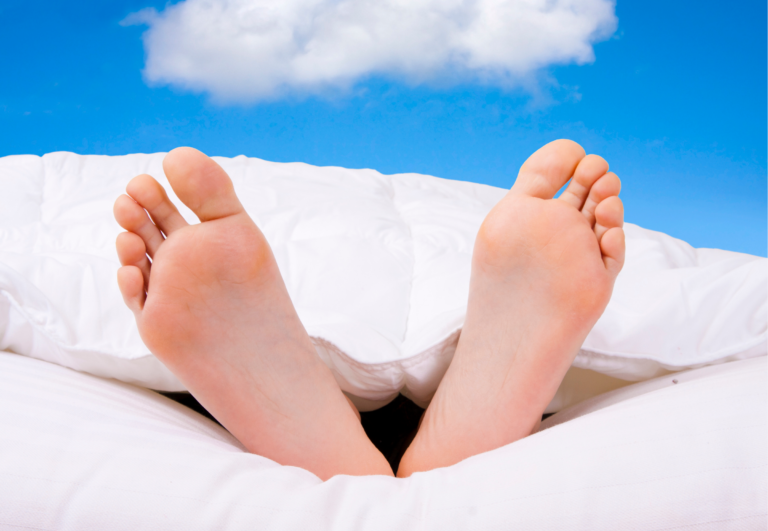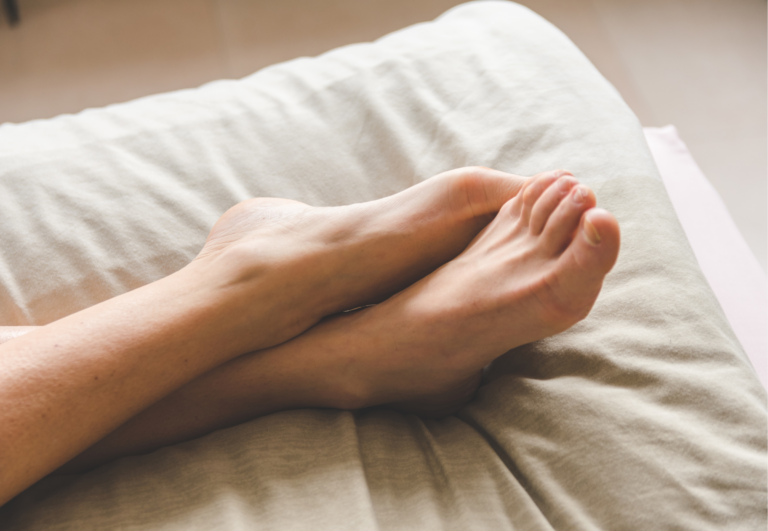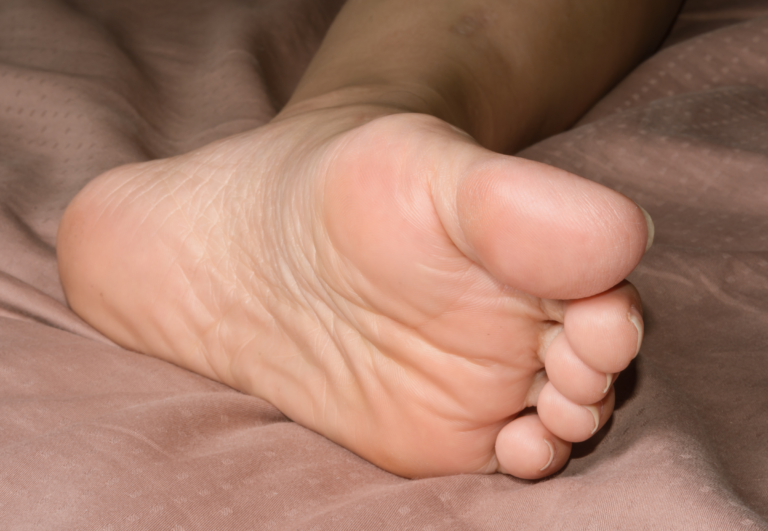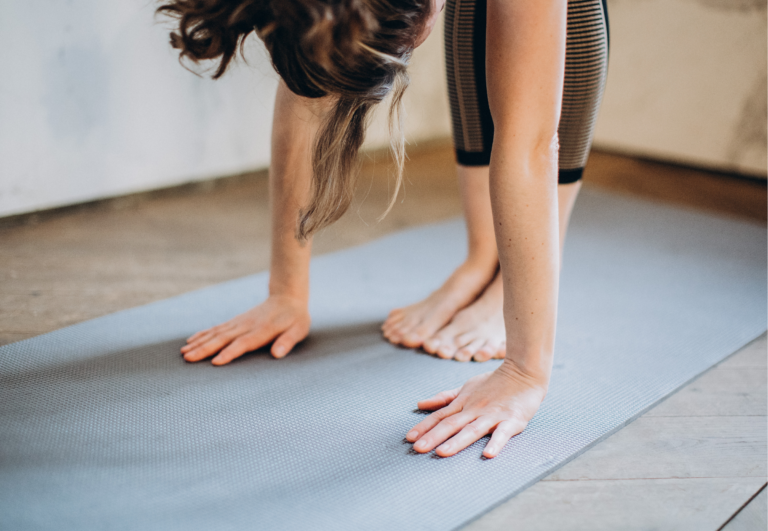Wearing Toe Spacers with Socks: Maximizing Comfort and Alignment
Toe spacers, often referred to as toe separators, have become a staple in the self-care routine of individuals looking to relieve foot pain and improve foot health. As someone who has integrated toe spacers into my regular wellness practice, I’ve experienced first-hand the benefits they offer. Wearing them with socks, specifically, adds a layer of convenience and comfort, allowing the spacers to work their magic throughout the day.
For those new to toe spacers, they are simple devices designed to reposition and align your toes to their natural shape. This realignment is key in alleviating stress on the foot. By using toe spacers when wearing socks, you’re not just nurturing your feet; you’re also ensuring that the benefits extend over a more extended period, promoting better posture and balance.
Integration of toe spacers into your life can be seamless. They fit snugly between your toes and can be worn with most sock types. The constant gentle pressure they provide helps in conditioning your feet gradually, which is essential for those of us spending long hours on our feet. With regular use, many can attest to a significant decrease in foot discomfort and overall improvement in toe alignment and foot structure.
Can You Wear Toe Spacers With Socks?
Yes, you can wear toe spacers with socks. It’s best to use socks that have individual toe sleeves, such as Injinji toe socks, to accommodate the spacers and ensure a comfortable fit. Regular socks can also be worn over toe spacers, but make sure they are not too tight, which could compress the toes and counteract the benefits of the spacers.
When incorporating toe spacers into your routine, it’s essential to choose the right type of socks and shoes. The goal is to maintain comfort and ensure effective use of the spacers, whether you’re dealing with flat feet, looking to improve blood flow, or simply aiming for better foot alignment.
When wearing toe spacers with socks, consider the following:
- Toe Sock Compatibility: Opt for toe socks that allow each toe to move freely and accommodate the spacers without restriction.
- Sock Material: Choose socks made from stretchy, breathable materials to prevent excessive compression and to enhance comfort while wearing spacers.
- Spacer Size: Ensure the toe spacers are not too bulky, as they need to fit comfortably within the confines of the socks and not cause undue pressure.
- Footwear Space: If wearing shoes over the socks and spacers, the shoes should have a wide toe box to prevent compression and allow for the added volume of the spacers.
- Activity Type: Consider the type of activity you’ll be doing. For sedentary activities or light walking, wearing toe spacers with socks may be more feasible than during vigorous exercise.
- Duration: Start by wearing the spacers with socks for short periods to ensure it’s comfortable and gradually increase the time as tolerated.
- Monitor for Discomfort: Pay attention to any signs of discomfort or circulation issues, and remove the spacers and socks if necessary.
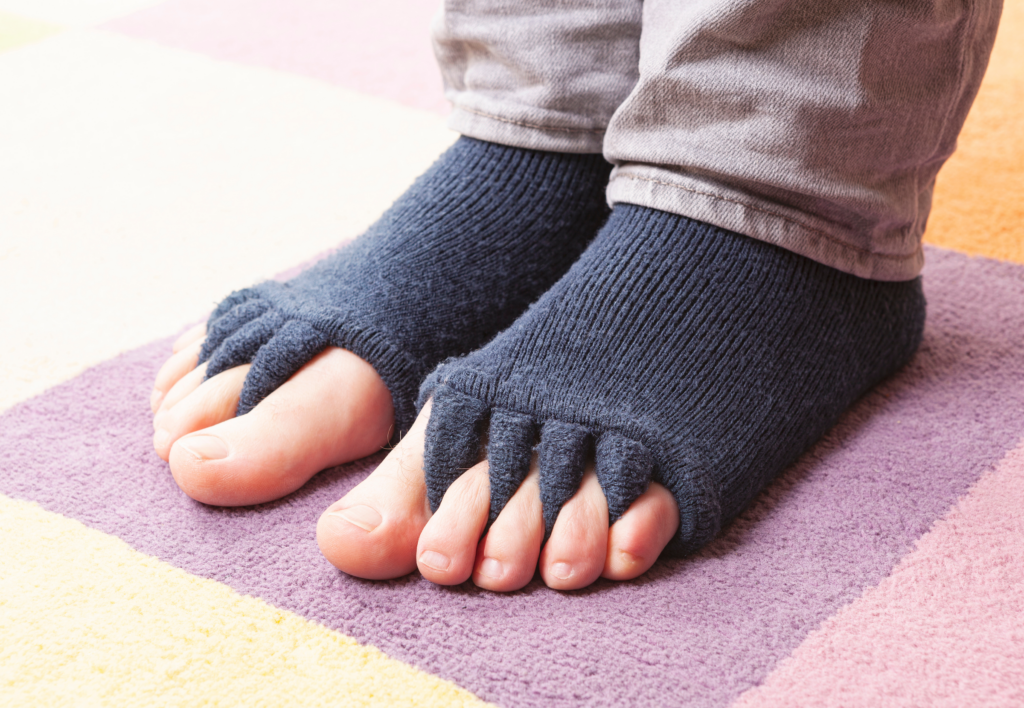
Choosing Compatible Socks
For toe spacers to work effectively, compatible socks play a critical role. Socks with individual toe sleeves, such as Injinji socks, accommodate spacers without causing bunching or discomfort. These socks can also help maintain the position of the spacers, providing stability as you move.
- Ideal Socks for Toe Spacers:
- Toe sleeve socks (e.g., Injinji)
- Seamless or wide-toe box designs
- Breathable and moisture-wicking materials
Note: Avoid tight-fitting socks, as they may compress the spacers and restrict blood flow, leading to discomfort.
Recommended Shoe Types
Shoe compatibility is just as crucial as choosing the right socks when wearing toe spacers.
The type of footwear you choose should have a wide toe box to prevent crowding and provide enough room for the spacers. Shoes designed for runners and those labeled as barefoot or minimalist shoes offer the most space and flexibility.
- Shoe Recommendations:
- Flat shoes with a wide toe box
- Barefoot shoes that mimic the natural foot shape
- Flexible and low-heel designs
Keep in Mind: High heels and shoes with narrow toe boxes should be avoided, as they can negate the benefits of toe spacers. Instead, opt for footwear that supports proper toe alignment and allows for sufficient toe spread.
By carefully selecting socks and footwear that are compatible with toe spacers, you can enhance the spacers’ effectiveness and enjoy greater comfort in your daily activities.
Potential Issues and Care
When incorporating toe spacers into your routine, there are a few potential issues to be mindful of, such as the risk of blisters and calluses. Proper care is crucial to prevent complications like infection and inflammation.
Addressing Common Concerns
Toe spacers are designed to realign toes and alleviate issues from tight shoes and narrow toe boxes, but may also cause friction or pressure points.
To minimize the chances of developing blisters, corns, and calluses, it’s vital to ensure that the spacers fit well and that your socks are not too tight, which could exacerbate problems. For individuals with diabetes or neuropathy, careful monitoring is necessary due to a reduced sensation in the feet which can lead to unnoticed injuries.
If you experience inflammation or persistent discomfort, consider reducing the time you wear them or consult a professional.
- Fit: Choose toe spacers that match your foot size to prevent overlapping toes or ingrown toenails.
- Sock Thickness: Opt for thicker, cushioned socks to reduce friction.
- Break-in Period: Start using them for short periods and gradually increase to allow your feet to adapt.
Maintenance and Hygiene
Keeping your toe spacers clean is essential to avoid infection and ensure their longevity. Follow these simple maintenance tips:
- Wash your toe spacers regularly with soap and water to remove any bacteria or fungi.
- Allow them to air dry completely before wearing them again to prevent moisture buildup.
- Inspect your spacers for signs of wear and tear, replacing them if they lose their shape or support.
| Care Tips | Description |
|---|---|
| Washing Frequency | Daily or after each use |
| Drying Method | Air dry; avoid direct heat |
| Replacement | When visible wear or deformation occurs |
By addressing common concerns and adhering to good maintenance and hygiene practices, you can safely use toe spacers to help manage various foot problems without unnecessary complications.
How to Use Toe Spacers
Toe spacers can be valuable tools for enhancing foot mobility and aiding in the recovery of certain injuries. They work by gently separating the toes to alleviate pressure and improve the alignment of the feet. Whether for daily wear or during specific foot exercises, it’s important to use them correctly to gain the most benefit.
Daily Use Guidelines
When incorporating toe spacers into your daily routine, start by wearing them for short periods to allow your feet to adjust. Simply slip the toe spacers between each toe, ensuring a snug but comfortable fit.
Wear them around the house with socks, ensuring the sock fabric accommodates the spacers without causing compression. Gradually increase the duration as your tendons and muscles adapt, aiming to maintain comfort. Toe spacers like Correct Toes are designed to be worn with wide-toed shoes, but they can also be used barefoot or with socks.
- First 1-2 weeks: Wear for 15-30 minutes a day
- After 2 weeks: Gradually increase to 1-2 hours
- Follow your own comfort
Note: If you experience any discomfort or pain, scale back the duration.
Exercise and Stretching
For those involved in activities like yoga or specific foot exercises, toe spacers can provide additional benefits.
Begin with gentle warm-ups to prepare your feet. Integrate toe spacers into your routine using exercises focused on the big toe to improve its mobility. Include stretches that target the entire foot, enhancing overall flexibility.
Example Foot Exercise Routine:
- Toe presses – press each toe down and hold for a few seconds
- Toe spreads – spread toes apart, then relax
- Toe curls – curl toes under and hold, then release
Exercise Tips:
- Use bold movements for each exercise
- Repetition: 3 sets of 10 for each exercise
- Duration: Total 10-15 minutes with toe spacers
Remember: While toe spacers can aid in injury recovery, they should complement a comprehensive recovery plan, and they’re not a substitute for professional medical advice.
By carefully integrating toe spacers into your daily wear and exercise routines, you can promote better foot health and functionality over time.
Types of Toe Spacers

Toe spacers can vary greatly in both material and design, each offering different benefits for comfort and foot health. As someone who uses toe spacers regularly, I’ve come to appreciate these differences firsthand.
Material Variations
- Silicone: The most popular, silicone toe spacers are soft and flexible, providing a comfortable fit. Silicone gel variations are often favored for their ability to conform to the toes.
- Foam: Foam toe spacers are lightweight and can cushion the toes effectively. However, they may not be as durable as silicone options.
- Medical-Grade Gel: These spacers are designed to offer higher durability and are sometimes infused with mineral oil to moisturize the skin.
- Medical-Grade Silicone: Known for their longevity and hygiene, medical-grade silicone toe spacers are often used post-operatively or for those with foot deformities.
Design Differences
- Open-Ended: Similar to Correct Toes®, these are designed to be worn with socks, allowing for each toe to be individually encased and aligned while active or at rest.
- Toe Loops: Some spacers come with loops to secure them to individual toes, ensuring they stay in place throughout the day.
- Full-Toe Sleeves: These encompass the entire toe, providing alignment and protection, particularly for those with blisters or corns.
In my experience, selecting the right material and design is crucial for achieving the desired outcome, whether it’s for comfort, toe realignment, or relief from foot ailments.
Benefits of Toe Spacers
Wearing toe spacers can significantly improve foot health. These simple devices support the natural alignment and promote the proper functioning of foot muscles.
Alleviating Foot Pain
Toe spacers are designed to reduce foot pain by separating the toes to their natural position. This can be especially helpful for individuals suffering from conditions like bunions, hammertoe, and plantar fasciitis. By keeping toes apart, friction and pressure on painful areas are lessened, leading to pain relief.
Improving Toe Alignment
Toes that are cramped or overlapping can lead to numerous foot problems. Toe spacers work to gently encourage correct toe alignment, which in turn, can help in managing and preventing foot deformities. Proper toe spacing can also improve foot strength and flexibility, which is advantageous for those dealing with arthritis.
Enhancing Balance and Stability
A natural toe spread provides a more stable base for standing and walking. Toe spacers can contribute to this by enhancing balance and stability. They enable the foot to distribute weight evenly, which may improve overall posture and gait.
By incorporating toe spacers into your routine, you can take a proactive step towards maintaining foot health and comfort. Remember, while I am experienced in this topic, it is always best to consult with a healthcare professional for personalized medical advice.
